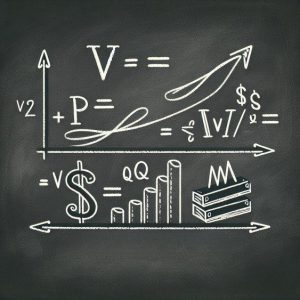
Lagging Indicator vs Leading Indicator: A Tale of Economic Prognostication
Dec 24, 2023
The world of economics and finance is filled with jargon and complex concepts, but few are as intriguing and vital as the dichotomy between lagging and leading indicators. These two indicators are crucial in predicting economic trends and market movements. Understanding the difference between a lagging indicator and a leading indicator can provide investors with valuable insights into the future direction of the economy and financial markets.
The Power of Leading Indicators: A Case Study
Leading indicators are economic factors that change before the economy starts to follow a particular pattern or trend. They are used to predict economic changes but are not always accurate. The ISM Manufacturing New Orders Index, is one leading indicator that has proven remarkably precise since the early 1950s.
The ISM Manufacturing New Orders Index, a subcomponent of the more popular ISM Manufacturing Index or the Purchasing Managers’ Index (PMI), examines industrial order activity in the United States. Despite the growing emphasis on technology and software in the U.S. economy, industrial activity remains a crucial measure of economic health.
The ISM Manufacturing New Orders Index is measured on a scale of 0 to 100, with 50 acting as the baseline. Any number above 50 signals U.S. industrial order activity expansion, while a figure below 50 marks contraction. The November reading came in at 48.3, indicating a modest level of contraction. This contraction marked the 15th consecutive month that the ISM Manufacturing New Orders Index was below 50.
The Recession Predictor: A Leading Indicator’s Tale
Interestingly, the ISM Manufacturing New Orders Index has a clear line-in-the-sand reading that’s previously been a precursor to recessions over the past 70 years. Readings below 43.5 have been followed by an eventual U.S. recession, without fail, for seven decades. This level has been breached twice over the past 15 months, suggesting a recession might be on the horizon.
Another example of a leading indicator is the stock market itself. Historically, the stock market tends to decline before the economy suffers a downturn. This is because investors may anticipate a recession and sell off their holdings in anticipation of falling profits.
Lagging Indicators: The Rearview Mirror of the Economy
While leading indicators are like a car’s headlights, illuminating the road ahead, lagging indicators can be likened to the rearview mirror, reflecting what has already passed. These economic variables do not change direction until the economy has begun to follow a particular trend or pattern. They often confirm what a leading indicator suggests, reinforcing the adage that the “Stock Market Is a Lagging Indicator.”
Unemployment Rate: A Classic Lagging Indicator
Take, for instance, the unemployment rate. This is a classic example of a lagging indicator. Firms often start laying off workers as a cost-cutting measure when an economy enters a recession. Consequently, the unemployment rate does not begin to rise until the economy has been in a downturn for some time. In other words, if the unemployment rate is increasing, the economy is likely already in a recession.
Delving Deeper into the Unemployment Rate
The unemployment rate is a crucial measure of economic health. A high unemployment rate is generally a sign of an ailing economy, where jobs are scarce and consumer spending is low. On the other hand, a low unemployment rate often signals a healthy economy with plentiful jobs and robust consumer spending. However, changes in the unemployment rate often lag behind changes in the broader economy.
When the economy starts to contract, companies do not immediately lay off workers. They might initially try to cut costs in other areas or hope the downturn is temporary. Similarly, companies do not immediately hire new workers when the economy begins to recover. They might try to increase productivity with their current workforce or wait to ensure sustainable recovery.
Business Cycle and Lagging Indicators
Understanding this lag can be particularly useful for investors. During the early stages of an economic recovery, lagging indicators such as the unemployment rate might still be painting a bleak picture. However, investors who understand that the “Stock Market Is a Lagging Indicator” can see beyond this to the nascent economic recovery. This can allow them to make investment decisions that take advantage of the upcoming upswing in the economy.
The Stock Market: A Lagging Indicator?
Interestingly, the stock market can also act as a lagging indicator. While it can anticipate economic downturns to some extent, it may also take time to reflect the underlying economic conditions fully.
During periods of economic recession, the stock market often experiences declines as investors react to negative economic indicators and uncertainties. However, the market’s bottom or lowest point may not align precisely with the official declaration of a recession’s end or the beginning of an economic recovery.
This lag can occur due to various reasons. Firstly, investor sentiment and market psychology can play a role. Even when economic indicators show improvement, investors may remain cautious and sceptical, leading to continued selling pressure in the market. This can delay the market’s recovery and cause it to reach its lowest point after the initial stages of economic recovery.
Secondly, the stock market is influenced by a wide range of factors beyond just the economy. Factors such as corporate earnings, geopolitical events, monetary policy decisions, and investor sentiment can all impact market movements. Therefore, these additional factors can influence the market’s timing and response to economic conditions, causing it to lag behind the economy.
However, one should note that while the stock market can be a lagging indicator in some cases, it is still an essential barometer of overall market sentiment and economic expectations. Investors and analysts often look to the stock market as a financial health and prospects gauge. However, it’s crucial to consider a broader range of economic indicators and factors when assessing the overall state of the economy.
Lagging Indicator vs Leading Indicator: The Balancing Act
In the world of economics and finance, the balancing act between lagging and leading indicators is a crucial one. These indicators, each with their unique characteristics and implications, provide a comprehensive view of the economy’s health and direction.
Leading Indicators: The Crystal Ball of the Economy
Leading indicators like the ISM Manufacturing New Orders Index resemble a crystal ball. They provide a heads-up about potential economic shifts, offering a glimpse into the future. These indicators change before the economy as a whole does, making them valuable tools for prediction. For instance, an increase in new orders for manufactured goods can signal an upcoming increase in production, which could lead to higher employment rates and potentially boost the economy.
On the other hand, lagging indicators, like the unemployment rate, offer confirmation that a trend is in place. They change after the economy has already begun to follow a particular trend. This characteristic makes them particularly useful for confirming the patterns that leading indicators suggest.
The Balancing Act: Using Both Indicators
However, neither type of indicator is infallible. Leading indicators can give false signals about the direction the economy is heading. For example, a surge in new manufacturing orders might not lead to increased economic activity if those orders are later cancelled.
Lagging indicators, on the other hand, can only tell us about changes that have already occurred. They are like looking in the rearview mirror; they show us where we’ve been, not where we’re going. For instance, a rising unemployment rate confirms that the economy has been in a downturn, but it doesn’t provide any insights into when it will recover.
Therefore, a savvy investor or economist will use a mix of both types of indicators to get a comprehensive view of the economy’s health and direction. They can make more informed decisions by balancing the forward-looking insights provided by leading indicators with the confirmatory information provided by lagging indicators.
The Role of Indicators in Investment Decisions
Understanding the interplay between leading and lagging indicators can be precious for investors. For example, suppose leading indicators suggest the economy is heading into a downturn, but lagging indicators have not yet confirmed this. In that case, an investor might adopt a more cautious investment strategy. They might shift their portfolio towards more defensive assets, which tend to hold up better during economic downturns.
On the other hand, if leading indicators suggest that the economy is recovering, but lagging indicators haven’t yet confirmed this, an investor might see this as an opportunity. They might shift their portfolio towards more cyclical assets, which perform better during economic upswings.
Conclusion: The Dance of the Indicators
In the intricate dance between lagging and leading indicators, we uncover a compelling narrative of economic foresight and retrospective confirmation.
Like a crystal ball, leading indicators provide an early warning system for potential economic shifts. The ISM Manufacturing New Orders Index, a prime example, offers a glimpse into the future by changing before the broader economy, making it a valuable predictive tool. Conversely, lagging indicators, like the unemployment rate, confirm established trends, reflecting changes that have already occurred.
As we navigate this balancing act, it becomes evident that neither indicator is foolproof. False signals from leading indicators and the retrospective nature of lagging indicators underscore the need for a nuanced approach. An astute investor or economist recognizes the synergy between both types, leveraging the forward-looking insights of leading indicators and the affirmative nature of lagging indicators to make informed decisions.
This interplay between indicators is not merely theoretical; it holds tangible implications for investment strategies. Understanding when to exercise caution or seize opportunities hinges on interpreting the signals from both categories of indicators. The result is a comprehensive understanding of the economy’s health and direction, guiding decisions in a dynamic financial landscape.
Investors and economists dance with indicators in the grand finale of this economic ballet. This choreography requires finesse, adaptability, and a keen eye for the present and the future.
Articles That Offer In-Depth Analysis

How Do You Win the Stock Market Game? Effective Strategies

A Sophisticated Approach: Do Bonds Increase Returns When the Stock Market Crashes?

Mastering Your Finances: Why You Need to Learn How to Manage Your Money with Grace

Why is the US Dollar Not Backed by Gold? Unveiling its Deadly Impact

Best Ways to Beat Inflation: Inspiring Insights from Contrarian Investors

Unveiling Falsehoods: Which of the Following Statements About Investing is False

How to Win the Stock Market Game: Cracking the Code

Which of the Following is True When the Velocity of Money Falls? Economic Slowdown

Investor Sentiment and the Cross Section of Stock Returns: Exploring the Hot Connections

Investing for Teenagers: Laying the Foundation for a Financially Stable Future

Building a Resilient Investment Strategy with 40/60 Portfolio Diversification

IBM Stock Price Forecast 2024: Examining IBM’s Strategic Vision

US Stock Market Crash History: Lessons for Earning

What Is Price to Sales Ratio?: Understanding a Key Valuation Metric



